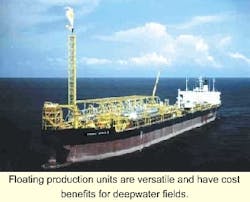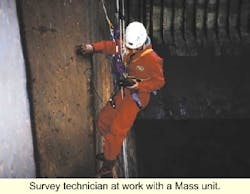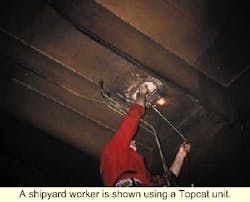FLOATING PRODUCTION: Inspection, evaluation methods help FPSOs, FSOs avoid drydocking
Danny Constantinis
David Mortlock
EM&I Ltd
The increasing use of floating production systems (FPS) in the offshore oil industry has driven the development of various methods and technologies that may have far reaching benefits for both commercial and military ships. The versatility and cost benefits of using FPS units for exploiting deepwater and marginal oil fields has made them very attractive to oil companies. However, there have been problems associated with having to drydock these ships at five-year intervals in order to meet traditional, prescribed class and regulatory requirements.
FPS units often produce above 100,000 b/d of oil, and at oil prices of $20/bbl, this represents a $2,000,000 loss of production for every day off station.
A typical drydock period can be 40-60 days for an FPS unit, which equates to $80-120 million of lost production, a significant difference to the downtime costs of drydocking a conventional trading ship. This is a very expensive burden to bear and, in an age of increasing cost cutting, has forced the oil industry to challenge the conventional way of ensuring the technical integrity of its assets.
In addition, inspection driven shutdown of process plants can incur similar penalties in terms of lost production. This paper looks at the oil industry approach to this problem and how a new way of operating such ship structures and process plants have evolved.
Most FPS units are ship-shaped and are often based on newbuild or converted trading tankers. Many FPS units anticipate remaining on station for extended periods (typically 5-20 years) without drydocking. During this period, they may need to function at above 95% availability to remain commercially viable.
Production levels can be around 100,000 b/d of oil, which at typical current oil prices can mean that a day's lost production can cost the operator around $2 million per day in lost revenue. The main causes of lost production are:
- Need to come off station for drydocking
- Shutdown of plant for inspection purposes.
A typical five-year drydocking will take an FPS off station for maybe 40-60 days with an overall loss of around $ 90-140 million. We can presume that another 20 days will be incurred on average for plant inspection shutdowns in the same five-year period at a further cost of another $40 million. These are powerful incentives to avoid drydocking and plant shutdowns.
Why drydock?
A good starting point in answer to the question of "Why drydock?"is to examine conventional tanker design and operating philosophies. Tankers may be designed with a 20-30 year fatigue life, but their operating philosophy assumes that during this period there will be a regular drydock schedule, generally at a maximum of five-year intervals, with in-water surveys being performed mid-period.
This is a prescriptive requirement, probably originally based on the need to renew antifoul coatings, and now embedded in international regulations and class society rules. Over the years, the period between drydockings has extended as coating technology and propulsion machinery reliability has improved. The time taken to renew antifoul coatings and fulfill the class requirements for drydock inspection of the hull is probably on the order of 10-15 days.
However, while drydocking is driven by prescriptive regulations, the occasion is normally used as an opportunity to carry out other inspection, maintenance, repair, and upgrade tasks. This extends the time out of service, and as there is often insufficient advance knowledge of structural and machinery condition to plan the workscopes precisely. The period out of service, and the costs, escalate still further. A further problem is that the act of opening up a tank or pipe for inspection often creates a safety hazard and reduces reliability.
Alternatives
One alternative methodology developed for dealing with this challenge is an asset integrity management system, or AIMS. The three stages involved in the process are: developing criticality based inspection and maintenance plans, managing the plans, and applying innovative inspection, maintenance, and repair methods. The plans are holistic and cover all areas of plant, machinery, process plant, marine piping, and control systems.
An operational criticality analysis (OCA) flow chart is developed and applied to all areas of plant and machinery. However, this paper will focus on the application of OCA to structures, marine piping, and static process plant, and areas where most innovative methods need to be developed. The OCA identifies the various components that make up the asset, highlights those items whose failure matters, and documents how (and how often) these items will be monitored and maintained, to ensure their integrity. Priority is given to safety, environmental, production and operational issues, in that order.
Thus, a component, whose failure puts human life at risk, rates the highest priority, while a failure that only increases costs, rates lowest. Judgement of failure mode and consequence is based on operator and industry experience as well as good engineering practice. Occasionally, quantitative risk analysis (QRA) will be used where there is insufficient historic data on which to base a judgement.
The result of the OCA study is an AIMS Plan that is specific to a ship, or to a class of ship. Each plan includes detailed work packs defining the method and scope for carrying out inspections and maintenance. The plan and work packs can be input into a variety of different electronic maintenance management systems.
Generally, the inspection and maintenance programs will change from a five-year periodic scheme to a continuous survey scheme. This ensures that representative inspections are carried out on critical parts of the structure on a regular basis, and confidence is gained as to the condition of the rest of the structure. Continuous surveys give early warning of deterioration, providing time to plan and execute remedial action while on station.
Plan management
The plans help develop a life cycle inspection and maintenance program, which in turn is used to prepare annual and five-year budgets. Annual workscopes are developed with more detailed 90-day plans and cost time resource (CTR) sheets for operational planning of inspection and maintenance campaigns.
Regular and formal review of inspection and maintenance data will strengthen and adapt the AIMS plan to meet changing operational and mission criteria. The plans develop an 'improved fit' with the asset as time goes on.
An efficient database for storing and retrieving the data is an essential item for AIMS to function efficiently and a number of different proprietary software systems have been used successfully. The regular review of the plans also serves to reduce costs by setting the cost time resources benchmarks for various activities and then seeking ways to drive the costs down.
An accompanying chart shows how costs of tank inspection were driven down for a North Sea FPS by using an AIMS plan.
Inspection, maintenance
The requirement for continuous maintenance and survey outside of a drydock or shipyard environment has led the industry to develop a number of innovative inspection repair and maintenance (IRM) methods. This is because conventional drydock methods are not suitable, or are too costly, to apply to an FPS on station. For example:
- Staging of tanks is both costly and damaging to existing coatings.
- Rafting the tanks to gain access is hazardous, especially in rough seas, and does not provide a stable platform for any but the most lightweight tasks to be performed.
- Cleaning and de-sludging of tanks is costly, time consuming, and involves disposing of sludge residues and exposure to hazardous substances.
- Carrying out hot-work involves emptying, cleaning, and gas-freeing not only the tank to be worked in, but all adjacent tanks that carry flammable materials.
These and other practical issues have been solved and implemented into the normal working routines of FPS units using an AIMS plan. There are two basic types: inspection and maintenance and repair.
Inspection
The requirement for close-up survey of structures involves gaining access to the structure and collecting reliable and recordable visual and ultrasonic gauging data. This requirement has been met using the MASS system, which is a structural inspection system combining access, survey, and reporting methods. The access method is an industrial version of rappelling, using the existing steel structure of the ship's tanks as anchor points.
The benefits of this approach over rafting are that the tanks can remain dry, and therefore, there is no dirty ballast water to deal with. Furthermore, the method is not sensitive to the ships motion and can be carried out while the ship is underway without safety risk or downtime resulting from rough weather conditions.
The method has proven to be safer than either staging or rafting and is accepted by regulators, provided that personnel are properly trained and certified. Close visual inspection (CVI) is carried out by the inspector and recorded on a helmet-mounted CCTV/video system.
Video images and the inspector's voice notes are transmitted to a console where they are recorded. Class surveyors or other engineering personnel can see what the inspector is seeing and can communicate and contribute to the survey, as required. If necessary, data can be sent real-time by satellite so that critical information can be simultaneously viewed around the globe.
A specialized analogue/digital ultrasonic thickness gauge is used, which can measure through paint or rough surfaces. The ultrasonic data is recorded and processed during the survey and becomes part of the permanent record of the inspection. A system known as Cobra can be used to inspect the area of bottom plating below bellmouth suctions without having to expend time and involve hot-work to remove the bellmouth for inspection.
Using a sub-miniature infrared CCTV camera, inserted under the bellmouth, the inspector is able to view the surface of the bottom plating under the bellmouth and simultaneously measure the plating thickness with an extended ultrasonic probe.
Another device, known as a "Glove" is used to obtain the natural dexterity of the human hand to enable piping and pressure vessels to be scanned ultrasonically for potential failure areas.
By introducing a flexible ultrasonic probe array into an industrial glove, the inspector's hand is transformed into a "multi-probe scanner," which when passed over the metal surface, detects the wall thickness. A statistical analysis package, known as "Analyze" takes thickness measurements and provides predictive early warning information of time to failure. This gives operators the opportunity to plan maintenance and/or renewal of corroded components.
The reliability of the data is automatically calculated as the inspection progresses. This ensures that the minimum number of data points is gathered for a selected confidence level. Greater confidence levels are generally required for the most critical systems.
Another device known as "Snoopy" is a remotely operated vehicle used to examine the internal bottom plating condition from outside the hull using an array of ultrasonic probes. This step avoids having to enter the tanks or clean the internal bottom plating surfaces for inspection.
The Snoopy surveys also include coating condition assessments and corrosion protection (CP) system surveys, as these are vital to the fitness for purpose of the in-water hull. It also maximizes availability of the tanks for normal operations as the inspections can take place with the tanks in service.
There is a marked reduction in pollution risk because tank internal cleaning and de-sludging is not required. This is of particular importance if there is a need to ensure the leak integrity of laid up ships in environmentally sensitive areas.
Maintenance
Extensive steel renewals are avoided by keeping coatings in good condition, especially within tanks. Technological advances in coating materials have led to moisture tolerant coatings, and coatings that can be used effectively underwater. This allows the maintenance of critical areas of hull structures that are normally immersed.
Conventionally, tank remedial coating programs have required scaffold-staging as the means of access, but experience has shown that, apart from the cost and inconvenience of this approach, scaffold-staging often damages the coatings during the erection and striking of the scaffold.
There is an alternative, known as "Topcat," which is a lightweight staging that can be rapidly assembled within the tank and rigged in such a way as to minimize coating damage. This type of staging also provides a stable platform for carrying out other work - for example, those involving cutting or reactive tools.
Lighter tasks, such as renewal of hydraulic lines or anode replacement, can be carried out using rope access methods without the need for staging. Similarly, installation and repair of electrical systems can be carried out cost effectively.
It is a safety requirement to clean and gas-free all tanks containing flammable materials that share a boundary with the tank where hot-work is taking place. This is a very limiting and costly restriction and takes many tanks out of service. An alternative is to enclose the work area in an containment area known as "Igloo," which is an air-proof, heat resistant fabric habitat.
By flowing low pressure, high volume air into the habitat, the overpressure within the habitat space excludes flammable gases from entering, enabling hot-work to take place without the need to clean and gas-free the adjacent tanks. Also, the use of specialized "low energy" welding methods allow welding where the opposite face of the plate is in a tank that contains water or even flammable materials.
Other innovations have been developed to deal with sea-chests, tailshaft and rudder inspections, keeping them fit for purpose without the need for drydocking. Undoubtedly, there are other innovations that will need to be developed, and these will evolve with time.
Case histories
AIMS methods have been applied to some 31 FPSOs and a number of British military ships.
- An FPSO in Indonesia under DNV Class was due for a 4th special survey and drydocking. The introduction of inspections and the plan enabled the owner to defer drydocking for a total 10-year period.
- An FPSO in China under ABS Class required extensive stiffening of a corroded transverse bulkhead in a produced water tank. Use of the special hotwork habitat and access platforms enabled this work to be carried out at sea, without stopping production.
- An FPSO required a survey of the bottom plating because of suspected pitting in the plating. The survey was carried out at sea and without entering the tank by using an evaluation ROV, with the additional benefit of not having to clean the tank internals, or having to deal with the potential health and pollution risks associated with sludge removal.
- A navy auxiliary ship required a special survey, but wanted to minimize the cost and time penalties involved in staging the tanks for survey. The survey was carried out using a Mass system in 50% of the time taken on a previous survey.
- A navy auxiliary unit required the retrofit of an upgraded sensor system in the tank spaces, but wished to avoid the use of conventional staging. The work was carried out by a Mass team to specification and cost savings were more than 25%.
The high downtime cost of FPS units has acted as the driver to increase availability and defer drydocking, using AIMS type systems. The holistic approach offers an acceptable alternative to conventional prescriptive rules for maintaining asset integrity.
Development of innovative inspection, repair and maintenance methods complements the AIMS approach by providing practical solutions to workscopes that would have been carried out in drydock.
Author
Danny Constantinis is the CEO of EM&I (Marine) Ltd. He began his career in the aerospace industry as an inspection engineer and has been a professional engineer and manager in the nuclear, offshore, petrochemical, and marine industries for many years.
David Mortlock is the Technical Director of EM&I (Australia) Pty Ltd and has been with the company since its inception. He began his career in the merchant navy as a navigating officer and has been a senior inspection technician, professional engineer, and manager in the nuclear, offshore, petrochemical, and marine industries.





